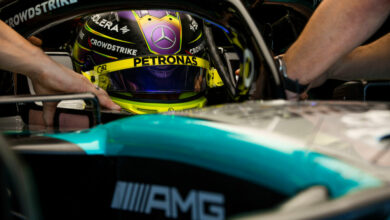McLaren’s Innovative Sustainable Move with Recycled Carbon Fibre at the Austin GP
In a groundbreaking initiative, McLaren has introduced recycled carbon fibre in its MCL60 race cars for the upcoming Austin Grand Prix, marking a significant stride towards sustainability in Formula 1. This sustainable shift, part of a trial with V Carbon, underscores McLaren’s commitment to reducing environmental impact in the sport.
Key Takeaways:
- McLaren’s collaboration with V Carbon introduces recycled carbon fibre (rCF) in select components of the MCL60, predominantly in the cockpit branding panels, heralding a new era in sustainable racing practices.
- The use of rCF is not only an environmentally conscious move but also a highly efficient one, offering a remarkable 90% reduction in life cycle emissions compared to standard carbon fibre, aligning with McLaren’s ongoing efforts to innovate and reduce its carbon footprint.
- McLaren’s history of pioneering the use of innovative materials in F1 dates back to the first all-carbon fibre chassis in 1981, and more recently, the integration of bio-based flax fibre in 2020, reinforcing its position as a leader in material innovation in the sport.

McLaren’s latest venture into sustainability was highlighted in a recent press release, stressing the significant environmental benefits of incorporating recycled carbon fibre. This strategic decision aligns with McLaren’s vision to minimise their ecological footprint, with rCF’s capability to drastically reduce life cycle emissions. The potential impact of this innovation is substantial; for instance, if just 1% of global carbon fibre production shifted to rCF in 2022, it could save approximately 32,535 tonnes of carbon emissions, a figure close to half of McLaren Racing’s total emissions for that year.
Piers Thynne, McLaren F1’s Chief Operating Officer, expressed the team’s pride in this pioneering initiative, stating, “We’re proud to team up with V Carbon to lead the charge in sustainable materials, running with recycled carbon fibre at the Austin GP.” This enthusiasm for sustainable innovation is echoed by Kim Wilson, McLaren Racing’s Director of Sustainability, who compared the development of a circular F1 car to a “moonshot,” highlighting the importance of innovation in achieving their ambitious sustainability goals.
The incorporation of rCF, which retains up to 85% of the original carbon fibre strength, doesn’t compromise the performance, demonstrating its potential not only in F1 but in various other applications. McLaren’s commitment to sustainable practices extends beyond the track, as they work with regulatory bodies and organizations to promote broader change in the industry.
In conclusion, McLaren’s decision to use rCF in critical components of their F1 cars represents a pivotal step in reducing greenhouse gas emissions associated with car manufacturing. This move at the US Grand Prix is a testament to McLaren’s ongoing dedication to innovation and sustainability, setting a new benchmark for environmental responsibility in the world of Formula 1 racing.




